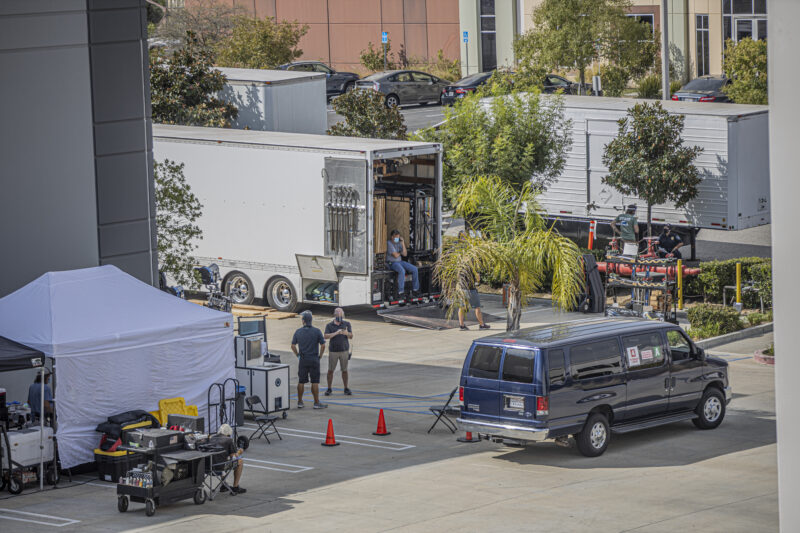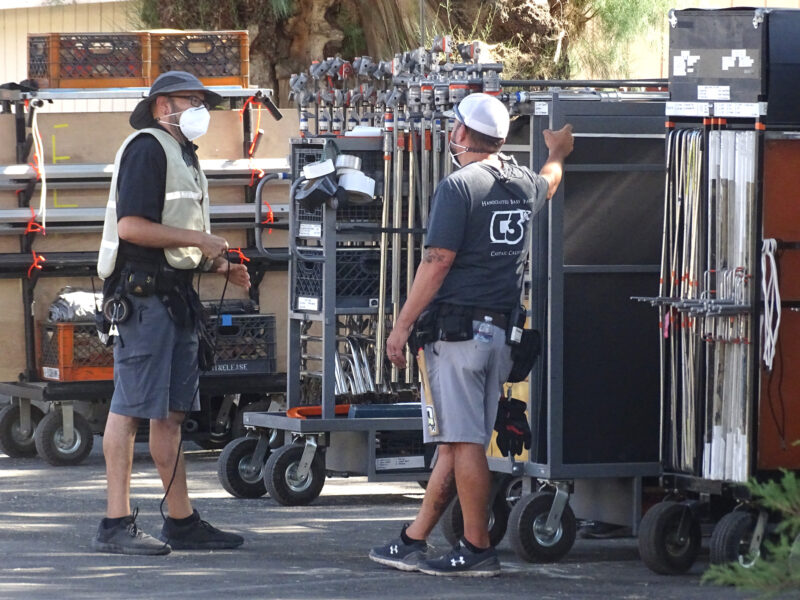By Emily Alvarenga & Perry Smith
When the coronavirus pandemic swept through California, the film industry, like many other businesses, came to a screeching halt.
Since then, productions have been given the go-ahead to resume — with a slew of new guidelines and protocols to follow.
Here in the Santa Clarita Valley, filming has begun to ramp up again, with a total of 120 film days per production being logged since the beginning of July, according to Matthew Curran, a project technician at the Santa Clarita Film Office.
Last year, 468 filming permits were issued for 1,249 film location days, which garnered an estimated economic impact of nearly $30.8 million, in the 2019-20 fiscal year that ended in June.
While Curran said the Film Office is beginning to see numbers slowly climbing to pre-COVID-19 rates, they do not anticipate this fiscal year to be nearly as successful as last year.
“As you know during the beginning of the (COVID-19) crisis, the film industry was hit hard and there was no activity,” Jason Crawford, economic development manager for the city of Santa Clarita, said. “However, over the past couple of months, filming is ramping up and we are seeing TV shows, movies and commercials filming throughout Santa Clarita again.”
That being said, productions filming locally are still adjusting to the reopening protocols put in place by the county Department of Public Health, along with state guidelines.
These protocols include many typically seen for other industries, such as physically distancing, requiring personal protective equipment, or PPE, screening employees for COVID-19 symptoms and frequent sanitization of the workplace.
“The Santa Clarita Film Office is currently following all the L.A. County health guidelines for reopening, … requires all the necessary social distancing and for all cast and crew to wear proper PPE,” Curran said. “Additionally, many productions are requiring covid testing prior to coming on set and doing regular temperature checks each day.”
Other changes include craft services and meals being required to be outdoors, while all food and drink must be single-serving only, with no communal food or drink service offered.
In addition, sets are now closed to the public, with strict covid safety measures in place to help social distancing from the general public and among the crew itself.

Motion picture precautions
One thing is for certain, filming a major motion picture shoot, like the one that was going on at the Backwoods Inn recently, takes a lot more time and attention these days.
A Valencia resident directing security for the shoot had to speak on the condition of anonymity to conceal the project before its media announcement.
“We try to keep a pretty tight lid on everything,” the person said, noting that as a local resident, he was very happy to see filming come back, and everybody wants to make sure it’s done safely so it can continue.
The current SCV set he’s working on has anywhere from 120-150 people working at one time, he said, so part of keeping everything safe and sanitary, in addition to numerous sanitizing stations and procedures, is to have the division separated into four pods, A, B, C and D, with A being, as you might imagine, the actors and actress, director, makeup crew and camera personnel and others who have to be closest to those individuals; with B pod being for lighting, scene construction, etc.; and so forth.
After one group from a designated pod enters the area, there’s an intense 10 minutes or so of cleaning and disinfecting that goes on, all of which adds hours to the day and, ultimately, probably millions to the budgets of these projects, all things considered, he added.
Part of that enormous cost is associated with the time that’s been added to the projects as a result, as the production company he’s working with for this shoot uses an 86-page guide for protocols that, he adds, are followed to the T.
The crew begins to arrive in the morning for a shoot that’s going to last well into the night, he said.
“You can imagine how long it takes to test, to stand 6 feet apart, to keep that social distancing, to make sure you’ve got your PPE on, make sure you’re always washing and sterilizing your hands,” he explained, “you can imagine how long it takes just to get started in the morning.”
As someone who’s part of the A pod, he gets tested every day with results that are “fast-tracked,” which no doubt also carries a significant cost.
While there’s a recent industry standard, which was developed in part by producer Steve Soderberg of the Director’s Guild, in consultation with experts he met while working on “Contagion,” production crews also have to work with union guidelines from the various guilds on set, as well.
“(Unions) have followed everything (with respect to health protocols) — we’re all a team here,” the person added. “At the end of the day, we all want to continue to work, and therefore the unions have been fantastic in working with our production.”


Movie ranches
At Melody Ranch, a family-run movie ranch and the infamous home to more than 1,900 Western films, filming has yet to get back to normal levels, which Daniel Veluzat, owner of the ranch, said definitely has to do with the daunting number of protocols now in place.
“We were doing ‘Penny Dreadful’ prior to COVID, and for us, luckily it just kind of worked out to where it went down on hiatus, and then COVID came, so we really didn’t lose anything; but now it’s a different story,” Veluzat added. “I took advantage of the time (off) and built a lot of new sets to prepare for when things do start to get back to normal, but we just have really no idea when all that’s going to be.”
Since then, nothing has been filmed at the ranch, though filming for smaller productions at the nearby Melody Ranch Studio backlot, a 200-acre motion picture studio, have begun to return.
“I think the larger projects have really been put on hold, but some of the smaller things, such as television and music videos, are ramping up, out on our backlot,” Veluzat said.
As a studio, the ranch is able to leave COVID-19 protocols up to each production.
“There’s certain guidelines the film industry has to follow, and those guidelines are directed more towards productions than they are the studio,” Veluzat added. “As far as for the studio, there’s not really a lot we can do, other than making sure the best we can that the production companies are putting in place the requirements.”
However, Veluzat said most productions have had COVID-19 teams on site, with nurses there to test the cast and crew and administer temperature checks throughout the day.
“People were checking in and getting a covid test, and they were either told to go home or they were told to proceed to work,” Veluzat added. “It’s a whole new world to get used to.”
While much of these protocols are left up to the production, Veluzat said his employees still follow their own protocols, as well.
“Our people at the studio all get tested, we get checked, and we wear the PPE gear and so on,” he said, “so, as for us, we’re all prepared.”
On top of that, Veluzat said he’s noticed an uptick in productions wanting to do things close to home.
“Some actors and actresses have stayed overnight on location in their secure facilities, and some chose, when they’re in Santa Clarita, to lease a home, stay in one spot and not travel,” he added. “So there’s a big push to do things in California, near their homes.”
Though Veluzat hopes that productions continue to come back as quickly as possible in the hopes of helping the thousands of industry workers out of a job, he knows they should take the cautious approach.
“I don’t want everyone to come back to work in a rush, and then we get stopped again because I feel like a second stop could really, really damage the industry,” he said. “I just wish all of our movie studios and ranches in Santa Clarita the best of luck with everything, and I hope that when the work comes back, that we’re all busy. I’m sure we’ll get the Santa Clarita film industry booming again.”


On location in the SCV
For L.A. Film Locations, COVID-19 has made the location scout’s role in the industry that much more essential, according to owner Monica Harrison.
“Studios and production companies are doing less cold scouting and relying on location services, such as L.A. Film Locations, more and more,” Harrison said. “It has had a positive effect on our business now that we are all finally back at work. … There is no way to make up for the loss of business for so many months, but we are very grateful to be so busy since August 2020.”
As far as the protocols go, COVID-19 has done for film locations what it has done for other aspects of the industry: require more time — more time to sanitize, more time to clean, before, during and after a shoot.
Fortunately for a film-location company, which primarily scouts locations for shoots, much of their work is done from an office, so most team members can work remotely when needed.
“Fortunately, (our office is) set up in a way that is very conducive to social distancing, so for us, it has not been difficult,” Harrison added. “We also send scouts on their own to many locations where in the past we would accompany them. The less we have face to face contact, the better.”









